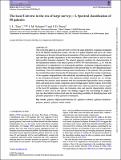Por favor, use este identificador para citar o enlazar a este item:
http://hdl.handle.net/10261/216689COMPARTIR / EXPORTAR:
 SHARE SHARE
 CORE
BASE CORE
BASE
|
|
| Visualizar otros formatos: MARC | Dublin Core | RDF | ORE | MODS | METS | DIDL | DATACITE | |

| Título: | The local universe in the era of large surveys. I. Spectral classification of S0 galaxies |
Autor: | Tous, J. L.; Solanes, J. M.; Perea, Jaime CSIC ORCID | Palabras clave: | Galaxies: elliptical and lenticular Galaxies: stellar content Galaxies: evolution Galaxies: formation Galaxies: general |
Fecha de publicación: | 21-may-2020 | Editor: | Oxford University Press | Citación: | Monthly Notices of the Royal Astronomical Society 495(4): 4135–4157 (2020) | Resumen: | This is the first paper in a series devoted to review the main properties of galaxies designated S0 in the Hubble classification system. Our aim is to gather abundant and, above all, robust information on the most relevant physical parameters of this poorly-understood morphological type and their possible dependence on the environment that could later be used to assess their possible formation channel(s). The adopted approach combines the characterisation of the fundamental features of the optical spectra of 68, 043 S0 with heliocentric z ≲ 0.1 with the exploration of a comprehensive set of their global attributes. A principal component analysis is used to reduce the huge number of dimensions of the spectral data to a low-dimensional space facilitating a bias-free machine-learning-based classification of the galaxies. This procedure has revealed that objects bearing the S0 designation consist, despite their similar morphology, of two separate sub-populations with statistically inconsistent physical properties. Compared to the absorption-dominated S0, those with significant nebular emission are, on average, somewhat less massive, more luminous with less concentrated light profiles, have a younger, bluer and metal-poorer stellar component, and avoid high-galaxy-density regions. Noteworthy is the fact that the majority of members of this latter class, which accounts for at least a quarter of the local S0 population, show star formation rates and spectral characteristics entirely similar to those seen in late spirals. Our findings suggest that star-forming S0 might be less rare than hitherto believed and raise the interesting possibility of identifying them with plausible progenitors of their quiescent counterparts.© 2020 The Author(s) Published by Oxford University Press on behalf of the Royal Astronomical Society | Versión del editor: | http://dx.doi.org/10.1093/mnras/staa1408e | URI: | http://hdl.handle.net/10261/216689 | DOI: | 10.1093/mnras/staa1408 | ISSN: | 0035-8711 |
| Aparece en las colecciones: | (IAA) Artículos |
Ficheros en este ítem:
| Fichero | Descripción | Tamaño | Formato | |
|---|---|---|---|---|
| IAA_2020MNRAS.495.4135T.pdf | 5,61 MB | Adobe PDF |  Visualizar/Abrir |
CORE Recommender
WEB OF SCIENCETM
Citations
10
checked on 23-feb-2024
Page view(s)
87
checked on 23-may-2024
Download(s)
111
checked on 23-may-2024
Google ScholarTM
Check
Altmetric
Altmetric
NOTA: Los ítems de Digital.CSIC están protegidos por copyright, con todos los derechos reservados, a menos que se indique lo contrario.
